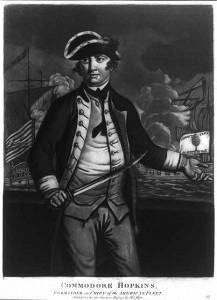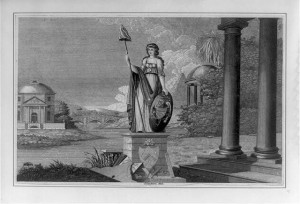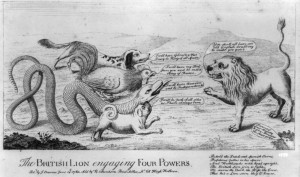Designing 18th-century flags

When people come together to form something new – a neighborhood club, a scouting troop, a sports team – they often design a flag or banner as a visible sign of their unity.
So it was for the 18th-century Americans who rebelled against Great Britain. As they created an army and navy, they needed new flags to carry into battle or fly from yardarms.
In May 1775, The Virginia Gazette, a leading colonial newspaper, reported that the Newport Light Infantry from Rhode Island had recently accepted “a suit of colours” from a merchant. In an address to the regiment, he explained that “I have endeavoured to throw such figures…into them as may lead you to an attention to the great objects which ought to possess the mind of every American soldier.”
 The “figures” included a woman representing America; a liberty cap to stress “the importance of liberty, civil and religious, to man;” and broken chains to symbolize how freedom would triumph “over violence and oppression.” He also included an anchor to represent hope, along with an accompanying slogan: “In God we hope.”
The “figures” included a woman representing America; a liberty cap to stress “the importance of liberty, civil and religious, to man;” and broken chains to symbolize how freedom would triumph “over violence and oppression.” He also included an anchor to represent hope, along with an accompanying slogan: “In God we hope.”
A year later, the Gazette told its readers about a naval flag designed to be “the colours of the American fleet.” Prominent on this banner was “a snake with thirteen rattles…described in the attitude of going to strike, with this motto, ‘Don’t tread on me.’”
The Gazette pointed out that “the ancients considered the snake…as an emblem of wisdom….The rattlesnake is properly a representative of America, as this animal is found in no other part of the world.”

The reptile’s positive aspects, the newspaper continued, included its eye, which “excels in brightness that of any other animal; she has no eyelid, and is therefore an emblem of vigilance; she never begins an attack, nor ever surrenders; she is therefore an emblem of…true courage.”
The article added that the rattler “when she is undisturbed…does not appear to be furnished with weapons of any kind; they are latent in the roof of her mouth, and even when extended for her defense, appear to those who are unacquainted with them, to be weak and contemptible; yet…their wounds, however small, are decisive and fatal.”

Hi James I was reading one of you articles https://www.gettysburgflag.com/blog/history-lessons/designing-18th-century-flags/ while trying to research a flag I’m working on at the TIverton R.I. Historical Society. I’m interested in the May 1775, The Virginia Gazette article you quoted. Do you know what page and what day in may that was published
Chris,
Thanks for writing. The article appeared in The Virginia Gazette’s issue of May 11, 1775, on page 3. Good luck with your project. Let me know how your research goes; it might make for a posting at gettysburgflag.com.
-Jim Breig